If I understand correctly you are thinking about a 414 P. Onken for LF and a constant directivity Ewave style waveguide for HF, correct? Would you use one of the standard EW x-overs?
MJ
Yes, although Im still not sure if Im going to try a more compact sealed enclosure with subs or a 614 due to its ease of fabrication and smaller size. Ive had most of the ply for the 614s cut for awhile but am attracted to the P. Onken for the coolness factor so some waffling has taken place.
Im going to use the Deluxe version which uses the B&C DE250 and QSC waveguide (the standard is a Selenium CD and Pyle/JBL wg). And of course, the values for the LP need to be adjusted for the 414s impedance.
amt
onken wave?
AMT,
How would you house the waveguide? Integrated into the Onken cabinet (like an EW) or "naked" on top?
MJ
Im going to use the Deluxe version which uses the B&C DE250 and QSC waveguide....
amt
AMT,
How would you house the waveguide? Integrated into the Onken cabinet (like an EW) or "naked" on top?
MJ
I am also considering a petite onken for a pair of 414 - trouble is I have never auditioned them. Combined with a pair of B&E DE500 in tractrix.
Anyway, I also got an eminence delta 12, first thought was to try and listen to the petite onken cabinet with the eminence speakers… but it seams they wont work well in the petite onken. Guess I will have to build and buy everything before been able to audition them :-(
Great thread! Will try to read it thoroughly!
Anyway, I also got an eminence delta 12, first thought was to try and listen to the petite onken cabinet with the eminence speakers… but it seams they wont work well in the petite onken. Guess I will have to build and buy everything before been able to audition them :-(
Great thread! Will try to read it thoroughly!
So if I use a SET with 16ohm taps, would the Onken or 614 grab another octave or add some dbs at the bottom? My other concern is that the Onken is quite alot of work and lumber so if it doesnt honestly outperform the 614, Id rather forego the extra hassle. I suppose Im still not sure what performance characteristics the Onken offers over a standard BR.
The sealed box w/ qtc .71 may be the easiest way to go.
Well, it would if mated to either if a matching impedance amp, but tap rating isn't the amp's out impedance rating. This is determined by its design topology, so unless you have published specs stating it as having 8 (16) ohms or a DF = 1, then odds are you'll have to trade some efficiency for the extra bass by inserting some extra series resistance with a non inductive power resistor.
Again, it's obvious tonal difference is due to vent's harmonics comb filtering with the driver's output to add a bit of 'richness' to the lower mids which is technically harmonic distortion. The same can be had by using a single large shelf vent or just one big round pipe placed close to the driver, it just doesn't look so industrial chic.
Regardless, the Onken is tuned down around 35 Hz whereas the 614 is up around 55 Hz, so it will take less EQ (series resistance) to flatten it and of course a higher XO point to a sub system will be required. Since bass bin location can be perceived with as low as a 40-60 Hz XO point depending the XO slope order, XOing lower is desirable if the bass bin can't be located somewhere along the plane between the mains, possibly making the Onken the better choice overall while a higher tuning can work well with multiple subs (typically (3)) properly positioned around the room.
One more time though, unless its 'look' is the prime reason for building the Onken, I recommend a MLTL for low tunings with its net Vb a function of the system's total impedance (series resistance). This will gain you the high damping at Fb same as the Onken, but without the lower mids distortion (more 'dry'/analytical sounding).
If sealed, then again, to get the correct Qtc requires knowing the system Q which will make it larger.
GM
Last edited:
GM makes a lot of good points. One thing I want to mention is that it is not necessarily the case that a subwoofer is required with Onkens. (>=15" based versions) Mine would not benefit significantly from their addition unless I had a fetish for the lowest organ stops which obviously the Onkens and few other bass speakers handle effectively. I have usable output down to the low 30Hz range as I have indicated in prior posts.
Make the box bigger and trade some efficiency with a higher Rg. In my case the Rg is mostly in my output transformer and would be there regardless as I use no feedback. The efficiency penalty has been paid as an intrinsic and unavoidable feature of my amplifier design so I am not paying it twice with additional R in the X-O, this also appears given the bogus way efficiency is specified these days to boost the Onken's efficiency by several dB in this scenario.. Something I mind not in the least. The above comment about box size and Rg should resonate with GM as I am more or less quoting him from the advice he gave me when I was designing and building mine. It works and in my case was essentially free and makes its easy to interface other amplifiers with somewhat lower impedance by adding series R..
Something I mind not in the least. The above comment about box size and Rg should resonate with GM as I am more or less quoting him from the advice he gave me when I was designing and building mine. It works and in my case was essentially free and makes its easy to interface other amplifiers with somewhat lower impedance by adding series R..
I was full of trepidation as I designed and built mine, and upon completion was relieved to discover that I actually liked them. i.e. They did the things I expected and weren't dreadfully flawed. My fall back plan was a standard set of large reflex enclosures if these didn't pan out, they never materialized as they clearly weren't needed.. For me committing the resources and money was a huge leap of faith as I had never heard a pair, but had heard a lot of other things that I wasn't really that thrilled with, and I wanted something clearly different.
Make the box bigger and trade some efficiency with a higher Rg. In my case the Rg is mostly in my output transformer and would be there regardless as I use no feedback. The efficiency penalty has been paid as an intrinsic and unavoidable feature of my amplifier design so I am not paying it twice with additional R in the X-O, this also appears given the bogus way efficiency is specified these days to boost the Onken's efficiency by several dB in this scenario..
I was full of trepidation as I designed and built mine, and upon completion was relieved to discover that I actually liked them. i.e. They did the things I expected and weren't dreadfully flawed. My fall back plan was a standard set of large reflex enclosures if these didn't pan out, they never materialized as they clearly weren't needed.. For me committing the resources and money was a huge leap of faith as I had never heard a pair, but had heard a lot of other things that I wasn't really that thrilled with, and I wanted something clearly different.
Last edited:
What kind of a 10-12" driver that's been sold today as new would do best in a cabinet that's sized like the petite onken?
I live in EU and since altec/GPA 414 must be ordered from USA, it won't be so cost-effective when taxes and postages are calculated to the total cost. The price could be anywhere up to 500 euros.
Thanks for your suggestions!
I live in EU and since altec/GPA 414 must be ordered from USA, it won't be so cost-effective when taxes and postages are calculated to the total cost. The price could be anywhere up to 500 euros.
Thanks for your suggestions!
Last edited:
What kind of a 10-12" driver that's been sold today as new would do best in a cabinet that's sized like the petite onken?
I live in EU and since altec/GPA 414 must be ordered from USA, it won't be so cost-effective when taxes and postages are calculated to the total cost. The price could be anywhere up to 500 euros.
Thanks for your suggestions!
Hello,
I live in EU also, i think that the price of the GPA 414 is not so high considering you will be keeping them very long. I bought my Altec 416 in 1982 and they are like new ones. In fact they are cheaper than they were 30 years ago.
best regards
jean
What kind of a 10-12" driver that's been sold today as new would do best in a cabinet that's sized like the petite onken?
I live in EU and since altec/GPA 414 must be ordered from USA, it won't be so cost-effective when taxes and postages are calculated to the total cost. The price could be anywhere up to 500 euros.
Thanks for your suggestions!
Not new but Tannoy Monitor Golds do very well in Onken cabs. I should know as i built some last year and they are keepers. 10" and 12" come up on Ebay quite often.
I built some "petite" Onkens for some Altec 414'z, but have found them a bit boomy ~80hz. So was thinking underdamped "oversize" cabinets. So i have been going around the Onken calculators i have found on the web to get a better understanding. I cannot get any of the calculators to match the internal volumes from the plans, all predict cabinet volumes around 40-50 litres less. Where am i going wrong? I have been using driver data from Bass drivers for DTQWT. Have done a sensitivity study on the parameters which seem to be insensitive, except for the inductor/wiring resistance.
( I am running the speakers off dedicated impedance matched PP amps, with PLLXO's crossing at 200Hz.)
( I am running the speakers off dedicated impedance matched PP amps, with PLLXO's crossing at 200Hz.)
Onken theory and "onken calculators"
The "onken-calculators" are often quite wrong...
The Onken box is really a slightly underdamped bass reflex with Vb = 6.4 * VAS * Qt^2 and Fb = 0.4 * Fs/Qt, and two rows of large rectangular vents (Sv_tot ~ Sd) on either side.
TS parameters for the classic Altec 414-8B and 416-8B are as follows:
414-8B) Sd = 556 cm2, Qts = 0.25 (but the final Qt depends on the added series resistance Rg), Fs = 29 Hz, Mms = 36 g, VAS = 380 L
416-8B) Sd = 835 cm2, Qts = 0.25 (but Qt again depends on Rg), Fs = 25 Hz, Mms = 61 g, VAS = 650 L
Assuming Rg = 0 (i.e. actively driven by a SS amp), you get 155 L / 45 Hz for the Petite Onken, and assuming Rg = 0.2 (e.g. passively driven by a SS amp with a low-loss series inductor in the X-over), you get 270 L / 39 Hz for the classic Onken.
Both are perfect matches with the box drawings.
For other Woofers and/or values of Rg, if you want to achieve the intended "Onken" tuning, it's better to re-design a new box from scratch than force the use of a poorly-matched "classic" design.
Calculating the correct vent size isn't quite as straightforward as usual, because of their peculiar placement and mutual interactions, and this is where most "onken-calculators" typically go (very) wrong.
Vent length has to take into account the shape of the vent (the more rectangular, the shorter), the placement flush with one side wall, and the average distance between the two sidewalls (the closer the walls, the shorter).
The formulas for the three correction factors are quite complex and involuted, so I cannot simply post them here. Also, they are inevitably still affected by a margin of error... so, really, optimizing a new Onken box ends up requiring lengthy (and possibly costly) fine tuning, by starting with longer vents and then shortening them (to raise Fb) or partially blocking some of them (to lower Fb). If this isn't enough to achive the intended Fb, there is no other option than scrapping the test box and starting anew.
Or, of course, just going for a more "normal" bass reflex box with a couple of largish round vents and the same Vb & Fb
Marco
The "onken-calculators" are often quite wrong...
The Onken box is really a slightly underdamped bass reflex with Vb = 6.4 * VAS * Qt^2 and Fb = 0.4 * Fs/Qt, and two rows of large rectangular vents (Sv_tot ~ Sd) on either side.
TS parameters for the classic Altec 414-8B and 416-8B are as follows:
414-8B) Sd = 556 cm2, Qts = 0.25 (but the final Qt depends on the added series resistance Rg), Fs = 29 Hz, Mms = 36 g, VAS = 380 L
416-8B) Sd = 835 cm2, Qts = 0.25 (but Qt again depends on Rg), Fs = 25 Hz, Mms = 61 g, VAS = 650 L
Assuming Rg = 0 (i.e. actively driven by a SS amp), you get 155 L / 45 Hz for the Petite Onken, and assuming Rg = 0.2 (e.g. passively driven by a SS amp with a low-loss series inductor in the X-over), you get 270 L / 39 Hz for the classic Onken.
Both are perfect matches with the box drawings.
For other Woofers and/or values of Rg, if you want to achieve the intended "Onken" tuning, it's better to re-design a new box from scratch than force the use of a poorly-matched "classic" design.
Calculating the correct vent size isn't quite as straightforward as usual, because of their peculiar placement and mutual interactions, and this is where most "onken-calculators" typically go (very) wrong.
Vent length has to take into account the shape of the vent (the more rectangular, the shorter), the placement flush with one side wall, and the average distance between the two sidewalls (the closer the walls, the shorter).
The formulas for the three correction factors are quite complex and involuted, so I cannot simply post them here. Also, they are inevitably still affected by a margin of error... so, really, optimizing a new Onken box ends up requiring lengthy (and possibly costly) fine tuning, by starting with longer vents and then shortening them (to raise Fb) or partially blocking some of them (to lower Fb). If this isn't enough to achive the intended Fb, there is no other option than scrapping the test box and starting anew.
Or, of course, just going for a more "normal" bass reflex box with a couple of largish round vents and the same Vb & Fb
Marco
Marco,
You are absolutely right.
This one exatly follows the Onken as I used the Petite Onken article in l´Audiophile (I still have all the volumes of the magazine as they are often good references).
One could add an option for added Rg in the left alternative without problems.
Did it in Swedish but it should not be be problem with the figures . Tab "Egen" is for your own designs.
. Tab "Egen" is for your own designs.
I also have a few 414-8A in my stash that I have measured and they all follow the specifications quite good.
http://www.revintage.se/Onken.xls
Note: L should often be somewhat shorter IRL.
You are absolutely right.
This one exatly follows the Onken as I used the Petite Onken article in l´Audiophile (I still have all the volumes of the magazine as they are often good references).
One could add an option for added Rg in the left alternative without problems.
Did it in Swedish but it should not be be problem with the figures
I also have a few 414-8A in my stash that I have measured and they all follow the specifications quite good.
http://www.revintage.se/Onken.xls
Note: L should often be somewhat shorter IRL.
Last edited:
I also have a few 414-8A in my stash that I have measured and they all follow the specifications quite good.
You're lucky. None that I have measured do.
Hi when i use the figures you quoted for the 414-8B i get the same size from the calculator. The data i have for the 414z suggested the volume of the box should be significantly smaller. Can i assume the petite onken was designed arround the 414-A/B not the 414z? This may explain why my boxes sounded underdamped- as they are too big.
i have made a "test"cabinet to allow me to fine tune the onken cabinet for my 414z's. The volume is adjustable (back can slide in and out) and i the vents are similar.
Question, how do i tune the cabinet,? Is it like a BR where i tune on impedance peaks, or is it something clever?
Question, how do i tune the cabinet,? Is it like a BR where i tune on impedance peaks, or is it something clever?
Here I want to give a tip a great low distorsion driver price on ebay 97euro.The "onken-calculators" are often quite wrong...
The Onken box is really a slightly underdamped bass reflex with Vb = 6.4 * VAS * Qt^2 and Fb = 0.4 * Fs/Qt, and two rows of large rectangular vents (Sv_tot ~ Sd) on either side.
TS parameters for the classic Altec 414-8B and 416-8B are as follows:
414-8B) Sd = 556 cm2, Qts = 0.25 (but the final Qt depends on the added series resistance Rg), Fs = 29 Hz, Mms = 36 g, VAS = 380 L
416-8B) Sd = 835 cm2, Qts = 0.25 (but Qt again depends on Rg), Fs = 25 Hz, Mms = 61 g, VAS = 650 L
Assuming Rg = 0 (i.e. actively driven by a SS amp), you get 155 L / 45 Hz for the Petite Onken, and assuming Rg = 0.2 (e.g. passively driven by a SS amp with a low-loss series inductor in the X-over), you get 270 L / 39 Hz for the classic Onken.
Both are perfect matches with the box drawings.
For other Woofers and/or values of Rg, if you want to achieve the intended "Onken" tuning, it's better to re-design a new box from scratch than force the use of a poorly-matched "classic" design.
Calculating the correct vent size isn't quite as straightforward as usual, because of their peculiar placement and mutual interactions, and this is where most "onken-calculators" typically go (very) wrong.
Vent length has to take into account the shape of the vent (the more rectangular, the shorter), the placement flush with one side wall, and the average distance between the two sidewalls (the closer the walls, the shorter).
The formulas for the three correction factors are quite complex and involuted, so I cannot simply post them here. Also, they are inevitably still affected by a margin of error... so, really, optimizing a new Onken box ends up requiring lengthy (and possibly costly) fine tuning, by starting with longer vents and then shortening them (to raise Fb) or partially blocking some of them (to lower Fb). If this isn't enough to achive the intended Fb, there is no other option than scrapping the test box and starting anew.
Or, of course, just going for a more "normal" bass reflex box with a couple of largish round vents and the same Vb & Fb
Marco
Calculated as above.
109liters -3dB 30Hz 96-97dB 1wmtr IMG-stageline(monacor) sp30-200neo wil make a great compact high efficient BR-enclosure. I calculated as above only with 35cm port length I have 50% Sd so not the 85% Sd as recomended for a real onken but this one comes close. It will make a great BR this 12" realy gows low and only 110liters= 3,85 cuft.
See the top-level low THD, plot at 100dB 1mtr. K3 <1% at 100dB between 50-700Hz! X-max 2mm perfect driver for low and medium power tube amps.
MONACOR INTERNATIONAL : Product Detail Page
I say this neodium-driver is a bargain for the DIY who want to save big money and get the best available quality.
Attachments
-
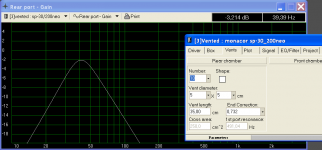 Schermafbeelding 2011-09-04 om 20.46.56.png36 KB · Views: 674
Schermafbeelding 2011-09-04 om 20.46.56.png36 KB · Views: 674 -
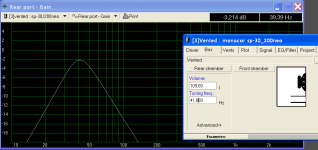 Schermafbeelding 2011-09-04 om 20.36.51.png34.5 KB · Views: 678
Schermafbeelding 2011-09-04 om 20.36.51.png34.5 KB · Views: 678 -
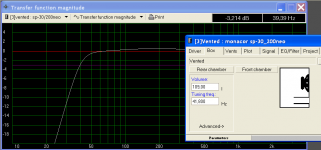 Schermafbeelding 2011-09-04 om 20.36.23.png34.4 KB · Views: 661
Schermafbeelding 2011-09-04 om 20.36.23.png34.4 KB · Views: 661 -
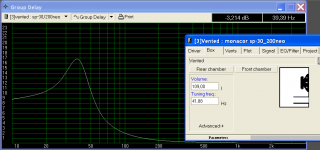 Schermafbeelding 2011-09-04 om 20.53.25.png36 KB · Views: 662
Schermafbeelding 2011-09-04 om 20.53.25.png36 KB · Views: 662 -
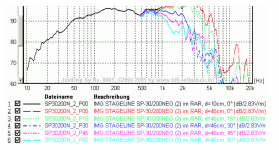 Schermafbeelding 2011-09-04 om 20.55.21.png103.5 KB · Views: 653
Schermafbeelding 2011-09-04 om 20.55.21.png103.5 KB · Views: 653 -
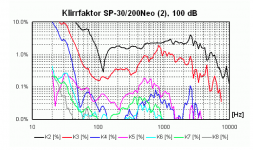 Schermafbeelding 2011-09-04 om 20.56.10.png107.2 KB · Views: 146
Schermafbeelding 2011-09-04 om 20.56.10.png107.2 KB · Views: 146 -
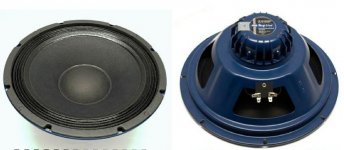 Schermafbeelding 2011-09-04 om 20.54.58.jpg37.2 KB · Views: 181
Schermafbeelding 2011-09-04 om 20.54.58.jpg37.2 KB · Views: 181
Last edited:
- Status
- This old topic is closed. If you want to reopen this topic, contact a moderator using the "Report Post" button.
- Home
- Loudspeakers
- Multi-Way
- Reviving the Onken